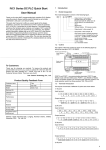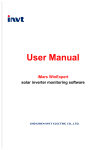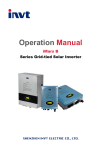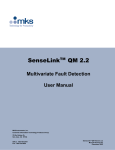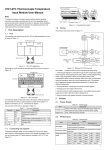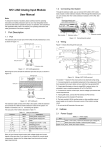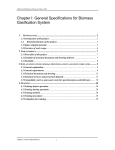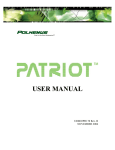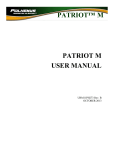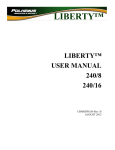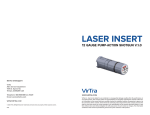Download IVC1-4PT RTD Module User Manual 1 Port Description 2 Indices
Transcript
1.3 Wiring IVC1-4PT RTD Module Figure 1-4 shows the wiring of the user port. User Manual Thermal resistance Thermal resistance Note: I1+ R1+ R1I1- I4+ To reduce the chance of accident, please carefully read the operating instructions and safety precautions prior to use. Only adequately trained personnel shall install or operate this product. In operation, strict compliance with applicable safety rules in the industry, the operating instructions and safety precautions in this book is required. ① R4+ ① CH 4 R4I4- 2 wire connection Thermal resistance AGND 4 wire connection ⑤ I2+ R2+ I1+ R1+ R1I1- CH 2 R2- Thermal resistance ① I2AGND I1+ 1 Port Description R1+ ① Thermal resistance CH 1 R1- I1+ R1+ R1I1- I1- 1.1 Port ① AGND ④ ② 24 V+ ③ +5V DC / DC Converter PGND The extension port and user port of IVC1-4PT are both protected by a cover, as shown in Figure 1-1. Removing the covers reveals the extension port and user port, as shown in Figure 1-2. 24Vdc V±10% 55mA FG 24 V- 3 wire connection AGND -5V EC10 - 4PT Figure 1-4 Wiring of IVC1-4PT user port The circled 1~5 stands for the five points to be observed during wiring. 1. Use shielded cables to input the thermal-resistor signal. Route them separate from power cable or any cable that may generate EMI. The requirements on the thermal-resistor signal input cable also include: 1) The thermal resistance sensor (Pt100, Cu100 or Cu50) can use 2-, 3-, or 4-wire system, the ascending measurem ent precisions. When the cable is longer than 10m, the 4-wire system is recommended. Figure 1-1 IVC1-4PT appearance Figure 1-2 IVC1-4PT ports The extension cable connects IVC1-4PT to the system, while the extension port connects IVC1-4PT to another extension module of the system. For details on connection, see 1.2 Connecting Into System. The user port of IVC1-4PT is described in Table 1-1. Table 1-1 2) To reduce the measurement error and avoid EMI, the cable should be shorter than 100 meters. The measurement error is due to the connecting cable’s impedance, and the error may differ with different channels even within the same module. Consequently we need to adjust the characteristics of each channel. See 3 Setting Characteristics for details. 2. If strong EMI exists, connect the shielding ground FG to the PG terminal. User port description Terminal Name 1 24V+ Analog power supply 24V+ 3. Properly ground module PG terminal. 2 24V- Analog power supply 24V- 3 FG Shielding ground 4. The basic module’s 24Vdc auxiliary output power or other qualified power supplies can be used as the power source for the analog circuit. GND 5. Short the unused channel as shown in the figure. 4 Description 5, 9, 13, 17 R1+ Positive thermal-resistor signal input of CH1 ~ CH4 6, 10, 14, 18 I1+ Auxiliary positive thermal-resistor signal input of CH1 ~ CH4 7, 11, 15, 19 R1- Negative thermal-resistor signal input of CH1 ~ CH4 I1- Auxiliary negative thermal-resistor signal input of CH1 ~ CH4 8, 12, 16, 20 Through the extension cable, you can connect IVC1-4PT to IVC1 series basic module or other extension modules. While through the extension port, you can connect other IVC1 series extension modules to IVC1-4PT. See Figure 1-3. Table 2-1 Item Extension cable Connecting into system Power supply Specification Digital circuit 5Vdc, 72mA (from basic module) 2.2 Performance Table 2-2 Extension m odule Performance Specification Item Rem ov ing extension port cov er before connection Figure 1-3 2.1 Power Supply 24Vdc (-15% ~ +20%), maximum allowable ripple voltage 5% Analog circuit 55mA (from basic module or external power supply) 1.2 Connecting Into System Basic m odule 2 Indices Celcius (°C) Fahrenheit (°F) Input signal Thermal resistance type: Pt100, Cu100 and Cu50 Channel No.: 4 Conversion speed (15 ± 2%) ms × 4 channel (no conversion for unused channels) Rated temperature range Pt100 -150°C ~ 600°C Pt100 -238°F ~ 1112°F Cu100 -30°C ~ 120°C Cu100 -22°F ~ 248°F Cu50 -30°C ~ 120°C Cu50 -22°F ~ 248°F 12-bit A/D conversion. The temperature readings are stored as 16-bit two's complement Digital output Pt100 -1500 ~ 6000 Pt100 -2380 ~ 11120 Cu100 -300 ~ 1200 Cu100 -220 ~ 2480 Cu50 -300 ~ 1200 Cu50 -220 ~ 2480 1 Specification Item Celcius (°C) Lowest resolution Fahrenheit (°F) Table 2-4 Pt100 0.2°C Pt100 0.36°F Cu100 0.2°C Cu100 0.36°F Cu50 0.2°C Cu50 0.36°F Precision ±1% of full range Isolation Between analog circuit and digital circuit: photocoupler. Between analog circuit and input 24Vdc power: internal isolation. Between analog channels: none 2.3 Buffer Memory IVC1-4PT exchanges data with the basic module through Buffer Memory (BFM). After IVC1-4PT is set through the host software, the basic module will write data into IVC1-4PT BFM to set the state of IVC1-4PT, and display the data from IVC1-4PT on the host software interface. See figures 4-1 ~ 4-4. Table 2-3 describes the contents of BFM of IVC1-4PT. Table 2-3 BFM BFM content Content Default Property #100 Average temperature of CH1 R #101 Average temperature of CH2 R #102 Average temperature of CH3 R #103 Average temperature of CH4 BFM#300 error state information Bit status of BFM#300 R ON (1) OFF (0) b0: system error b1 or b2 is 1 (A/D convertion of all channels stopped) Normal b1: channel characteristic setting error Channel characteristics setting error in BFM Channel characteristics setting normal b2: power supply failure 24Vdc power failure Power supply normal b3: hardware fault Fault with A/D convertor or other hardware Hardware normal b4 ~ b9: reserved - - b10: digital range error A/D conversion digital output exceeds Digital output the range of -2048 ~ 2047 value normal b11: average sampling times setting error Setting outside normal range (in this Setting within case, the previous valid setting will be normal range: restored) 1~256 b12 ~ b15: reserved - - 5. See Table 2-5 for the state information of BFM#301. Table 2-5 Channel BFM#301 state information Bit 1 0 b0 CH1 temperature below lower limit CH1 normal #200 Present temperature of CH1 R #201 Present temperature of CH2 R b1 CH1 temperature above upper limit CH1 normal #202 Present temperature of CH3 R b2 CH2 temperature below lower limit CH2 normal CH2 temperature above upper limit CH2 normal 1 2 #203 Present temperature of CH4 R b3 #300 Error state word 1 R b4 CH3 temperature below lower limit CH3 normal #301 Error state word 2 R b5 CH3 temperature above upper limit CH3 normal CH4 temperature below lower limit CH4 normal CH4 temperature above upper limit CH4 normal - - 3 #600 Thermal resistance type and temperature mode select 0 H0000 RW 4 b6 b7 #700 Sampling times for average of CH1 8 RW Reserved b8 ~ b15 #701 Sampling times for average of CH2 8 RW #702 Sampling times for average of CH3 8 RW #703 Sampling times for average of CH4 8 RW #800 Characteristic setting confirmation command 0 H0000 RW #900 CH1-D0 0 RW W orking m ode for CH1 #901 CH1-A0 0 RW W orking m ode for CH2 #902 CH1-D1 6000 RW W orking m ode for CH3 #903 CH1-A1 6000 RW W orking m ode for CH4 #904 CH2-D0 0 RW #905 CH2-A0 0 RW #906 CH2-D1 6000 RW #907 CH2-A1 6000 RW #908 CH3-D0 0 RW #909 CH3-A0 0 RW #910 CH3-D1 6000 RW SN Value of X #911 CH3-A1 6000 RW 1 0 Pt100 thermal resistance, digital signal unit: 0.1°C #912 CH4-D0 0 RW 2 1 Pt100 thermal resistance, digital signal unit: 0.1°F #913 CH4-A0 0 RW 3 2 Cu100 thermal resistance, digital signal unit: 0.1°C #914 CH4-D1 6000 RW 4 3 Cu100 thermal resistance, digital signal unit: 0.1°F #915 CH4-A1 6000 RW 5 4 Cu50 thermal resistance, digital signal unit: 0.1°C #4094 Module software version 0x1000 R 6 5 Cu50 thermal resistance, digital signal unit: 0.1°F #4095 Module ID H5041 R 7 6~F Explanation: 1. CH1 stands for channel 1; CH2, channel 2; CH3, channel 3, and so on. 2. Property explanation: R means read only. An R element cannot be written. RW means read and write. Reading from a non-existent element will get 0. 3. BFM#200 ~ BFM#203: present temperature. This value uses the unit of 0.1°C or 0.1°F (as determined by BFM#600). For example, 1000 means 100°C (or 100°F, as determined by BFM#600 and BFM#601). The average temperature is stored in BFM#100 ~ BFM#103. 4. BFM#300: Error state word 1. See Table 2-4 for its error state information. 6. BFM#600: channel mode setting, used to set the working modes of CH1 ~ CH4. See Figure 2-1 for their correspondence. # 600 0x × × 4 Figure 2-1 3 × 2 × 1 Mode setting element vs. channel See Table 2-6 for the meaning of “X”. Each channel’s conversion time is 15ms. When a channel is closed, the channel will not perform A/D conversion, reducing the total conversion time. Table 2-6 Meanings of X in the format Corresponding mode Channels closed 7. BFM#700 ~ BFM#703: average sampling times setting. Range: 1 ~ 256. If the setting is outside this range, the default value 8 will be used. 8. BFM#900 ~ BFM#915: channel characteristics settings, which are set using two-point method. D0 and D1, in 0.1°C unit, represent the channel’s digital outputs, while A0 and A1, also in 0.1°C unit, the actual temperature inputs. Each channel occupies 4 words. Note: the characteristic parameters are all in 0.1°C unit. As for those parameters in Fahrenheit unit, convert them into Celsius unit through the following format before writing them into the characteristic setting: Celsius = 5/9 × (Fahrenheit - 32) 11. BFM#4094: module software version, displayed automatically as Module Version in IVC1-4PT Configuration dialogue box of the host software, as shown in Figure 4-1. 4 Application Example 12. BFM#4095: module ID. The ID of IVC1-4PT is 0x5041. The user program in PLC can use this ID to identify the module before transceiving data. 4.1 Basic Application 3 Setting Characteristics The input channel characteristics of IVC1-4PT are the user adjustable linear relationship between the channel’s analog input A and digital output D. Each channel can be considered as the model shown in Figure 3-1. As it is of linear characteristic, the channel characteristic can be defined by two points: P0 (A0, D0) and P1 (A1, D1), where D0 is the channel digital output corresponding to analog input A0, and D1 is the channel digital output corresponding to analog input A1. D(0.1°C) Example: The IVC1-4PT module address is 0. Connect CH1 to Pt100 thermal resistance to output Celsius data, CH2 to Cu100 thermal resistance to output Celsius data, and CH3 to Cu50 to output Fahrenheit data and close CH4. Set the average sampling times to 4, and use data registers D1, D2 and D3 to receive the average value. See Figure 4-1 ~ Figure 4-3 for the setting method. For further details, see IVC Series PLC Programming Manual. P1 D1 A Analog input D0 D Channel D igital output Channel model Figure 3-1 A(0.1°C) P0 A0 A1 IVC1-4PT channel characteristic The measurement error is caused by the impedance of the connecting cable. You can correct it by setting the channel characteristic. To simplify the operation process without affecting functions, A0 and A1 are respectively fixed to the analog 0 and 6000 (in 0.1°C unit) in the current mode. That is to say, in Figure 3-1, A0 is 0.0°C and A1 is 600°C, which are not adjustable. Figure 4-1 Setting CH1 Figure 4-2 Setting CH2 Figure 4-3 Setting CH3 If you set the channel mode (BFM#600) without changing D0 and D1 of the corresponding channel, the channel characteristic vs. mode should be as shown in Figure 3-2. D( 0.1 ℃) 6000 A( 0.1 ℃) 0 -1000 6000 -1000 Default (not adjusted) Figure 3-2 Characteristics vs. mode without changing D0 and D1 Note: When the mode is set to 1 or 3, or say, when the output is in 0.1°F unit, the temperature data read from the output data zone (BFM#100~#103, #200~#203) will be in 0.1°F unit, but the data in the channel characteristics setting zone (BFM#900~#915) will still be in 0.1°C unit. That is to say, the data in the channel characteristics setting zone (BFM#900~#915) can only be in 0.1°C unit. Keep this in mind when changing the values of D0 and D1. You can change the characteristics by changing D0 and D1. The setting range of D0 is -1000 ~ +1000 (0.1°C); D1, 5000~7000 (0.1°C). If the setting is outside this range, IVC1-4PT will not accept it, but maintain the original valid setting. Figure 3-3 provides for your reference an example of characteristics adjustment when the measured value is 5°C (41°F) higher the actual value. D(0.1℃) 5950 -950 0 -50 P 0 1000 Figure 3-3 P 1 A(0.1 ℃) 6000 D0 =-50; D1 = 5950 Change characteristic 4.2 Changing Characteristics Example: The IVC1-4PT module address is 0. Connect CH1 to Pt100 thermal resistance to output Celsius data, CH2 to Cu100 thermal resistance to output Celsius data, CH3 to Cu50 to output Fahrenheit data and close CH4. They all have the characteristics shown in Figure 3-3 (the 3 IVC1-4PT measured temperature is 5°C/41°F higher than the actual one). In this case, CH1, 2 and 3 will output respectively 6000, 1200 and 2480 at the actual measured temperature of 600°C, 120°C and 248°F. Use data registers D1, D2 and D3 to receive the average value. The channel characteristic adjusting method is shown in Figure 4-4. Note that the unit is Celsius, and the adjusting range is within ±1000 (±100°C). Notice 1. The warranty range is confined to the PLC only. 2. Warranty period is 18 months, within which period INVT Auto-control Technology Co. Ltd. conducts free maintenance and repairing to the PLC that has any fault or damage under the normal operation conditions. 3. The start time of warranty period is the delivery date of the product, of which the product SN is the sole basis of judgment. PLC without a product SN shall be regarded as out of warranty. Figure 4-4 Changing characteristic 5 Operation Inspection 4. Even within 18 months, maintenance will also be charged in the following situations: Damages incurred to the PLC due to mis-operations, which are not in compliance with the User Manual; Damages incurred to the PLC due to fire, flood, abnormal voltage, etc; Damages incurred to the PLC due to the improper use of PLC functions. 5.1 Routine Inspection 1. Check that the analog input wiring meets the requirement (see 2.4 Wiring). 2. Check that the extension cable is properly inserted into the extension port of the basic module. 3. Check that the 5V and 24V power supplies are not overloaded. Note that the digital circuit of IVC1-4PT is powered by the basic module through the extension cable. 4. Check the application, and make sure the operation method and parameter range are correct. 5. Set the IVC1 basic module to RUN state. 5.2 5. The service fee will be charged according to the actual costs. If there is any contract, the contract prevails. 6. Please keep this paper and show this paper to the maintenance unit when the product needs to be repaired. 7. If you have any question, please contact the distributor or our company directly. Inspection Upon Fault In case of abnormality, check the following items: Shenzhen INVT Auto-control Technology Co., Ltd. ● The status of the POWER indicator ON: the extension cable is properly connected; OFF: check the extension cable connection and the basic module. ● The wiring of analog input Address: Gaofa Industry Park, Longjing ,Nanshan District 518055, Shenzhen China Hom epage: www.invt.com.cn ● The status of the 24V indicator ON: 24Vdc power supply normal; Version V1.0 Revision date September 28, 2011 OFF: 24Vdc power supply faulty, or IVC1-4PT faulty. ● The RUN indicator Flashing quickly: IVC1-4PT normal. OFF or flashing slowly: Check the Error Status in IVC1-4PT Configuration dialogue box through the host software. All rights reserved. The contents in this document are subject to change without notice.







